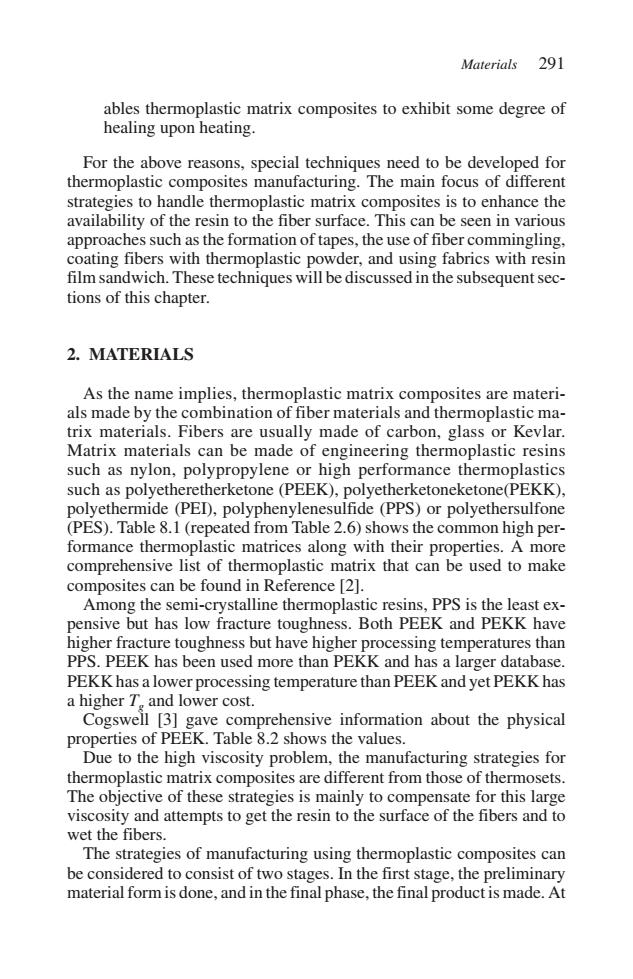正在加载图片...

Materials 291 ables thermoplastic matrix composites to exhibit some degree of healing upon heating. For the above reasons,special techniques need to be developed for thermoplastic composites manufacturing.The main focus of different strategies to handle thermoplastic matrix composites is to enhance the availability of the resin to the fiber surface.This can be seen in various approaches such as the formation of tapes,the use of fiber commingling, coating fibers with thermoplastic powder,and using fabrics with resin film sandwich.These techniques will be discussed in the subsequent sec- tions of this chapter. 2.MATERIALS As the name implies,thermoplastic matrix composites are materi- als made by the combination of fiber materials and thermoplastic ma- trix materials.Fibers are usually made of carbon,glass or Kevlar. Matrix materials can be made of engineering thermoplastic resins such as nylon,polypropylene or high performance thermoplastics such as polyetheretherketone (PEEK),polyetherketoneketone(PEKK), polyethermide(PED,polyphenylenesulfide (PPS)or polyethersulfone (PES).Table 8.1(repeated from Table 2.6)shows the common high per- formance thermoplastic matrices along with their properties.A more comprehensive list of thermoplastic matrix that can be used to make composites can be found in Reference [2]. Among the semi-crystalline thermoplastic resins,PPS is the least ex- pensive but has low fracture toughness.Both PEEK and PEKK have higher fracture toughness but have higher processing temperatures than PPS.PEEK has been used more than PEKK and has a larger database. PEKK has a lower processing temperature than PEEK and yet PEKK has a higher T and lower cost. Cogswell [3]gave comprehensive information about the physical properties of PEEK.Table 8.2 shows the values. Due to the high viscosity problem,the manufacturing strategies for thermoplastic matrix composites are different from those of thermosets. The objective of these strategies is mainly to compensate for this large viscosity and attempts to get the resin to the surface of the fibers and to wet the fibers. The strategies of manufacturing using thermoplastic composites can be considered to consist of two stages.In the first stage,the preliminary material form is done,and in the final phase,the final product is made.Atables thermoplastic matrix composites to exhibit some degree of healing upon heating. For the above reasons, special techniques need to be developed for thermoplastic composites manufacturing. The main focus of different strategies to handle thermoplastic matrix composites is to enhance the availability of the resin to the fiber surface. This can be seen in various approaches such as the formation of tapes, the use of fiber commingling, coating fibers with thermoplastic powder, and using fabrics with resin film sandwich. These techniques will be discussed in the subsequent sections of this chapter. 2. MATERIALS As the name implies, thermoplastic matrix composites are materials made by the combination of fiber materials and thermoplastic matrix materials. Fibers are usually made of carbon, glass or Kevlar. Matrix materials can be made of engineering thermoplastic resins such as nylon, polypropylene or high performance thermoplastics such as polyetheretherketone (PEEK), polyetherketoneketone(PEKK), polyethermide (PEI), polyphenylenesulfide (PPS) or polyethersulfone (PES). Table 8.1 (repeated from Table 2.6) shows the common high performance thermoplastic matrices along with their properties. A more comprehensive list of thermoplastic matrix that can be used to make composites can be found in Reference [2]. Among the semi-crystalline thermoplastic resins, PPS is the least expensive but has low fracture toughness. Both PEEK and PEKK have higher fracture toughness but have higher processing temperatures than PPS. PEEK has been used more than PEKK and has a larger database. PEKK has a lower processing temperature than PEEK and yet PEKK has a higher Tg and lower cost. Cogswell [3] gave comprehensive information about the physical properties of PEEK. Table 8.2 shows the values. Due to the high viscosity problem, the manufacturing strategies for thermoplastic matrix composites are different from those of thermosets. The objective of these strategies is mainly to compensate for this large viscosity and attempts to get the resin to the surface of the fibers and to wet the fibers. The strategies of manufacturing using thermoplastic composites can be considered to consist of two stages. In the first stage, the preliminary material form is done, and in the final phase, the final product is made. At Materials 291